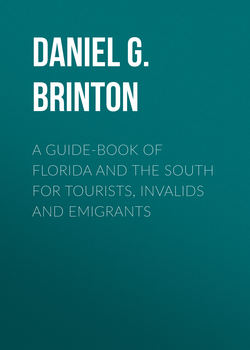Читать книгу A Guide-Book of Florida and the South for Tourists, Invalids and Emigrants - Brinton Daniel Garrison - Страница 8
PART I.
SOUTHERN ROUTES
6. SAVANNAH TO JACKSONVILLE
ОглавлениеThe tourist has the choice of three routes for this part of his journey. He can take a sea steamer, and passing out the Savannah river, see no more land until the low shores at the mouth of the St. John River come in sight. Or he can choose one of several small steamboats which ply in the narrow channels between the sea-islands and the main, touching at Brunswick, Darien, St. Catharine, Fernandina, etc., (fare $10.00). Or lastly he has the option of the railroad, which will carry him through to Jacksonville in twelve hours and a half, in a first class sleeping car.
The channel along the coast lies through extensive salt marshes, intersected by numerous brackish creeks and lagoons. The boats are small, or they could not thread the mazes of this net-work of narrow water-courses. The sea-islands, famous all over the world for their long-staple cotton, have a sandy, thin soil, rising in hillocks and covered with a growth of live-oak, water-oak, bay, gum and pine. Between the islands and the main land the grassy marshes extend for several miles. In the distance the western horizon is hedged by a low wall of short-leaved pine. The sea islands are moderately healthy, but the main land is wet, flat and sterile, and its few inhabitants are exposed to the most malignant forms of malarial fever and pneumonia.
On St. Catharine island is the plantation formerly owned by Mr. Pierce Butler, and the scene of Mrs. Francis Kemble Butler’s well-known work, “Life on a Georgia Plantation.” On Cumberland island, the most southern of the sea-islands belonging to Georgia, is the Dungerness estate, 6000 acres in extent, once owned by Gen. Nat. Greene, of Revolutionary fame, and recently bought by Senator Sprague, of Rhode Island, for $10 per acre. With proper cultivation it would yield magnificent crops of sea-island cotton.
Fernandina on Amelia Island, the terminus of the Fernandina and Cedar Keys Railroad, is a town of growing importance (pop. about 2,000; hotels, Virginia House, containing the telegraph office; the Whitfield House, both $3.00 per day; newspaper, the Island City Weekly.) This is one of the old Spanish settlements, and the traces of the indigo fields are still visible over a great part of the island. Fernandina-Oldtown is about a mile north of the present site.
The sub-tropical vegetation is quite marked on the island. Magnificent oleanders, large live oaks, and dense growths of myrtle and palmettos conceal the rather unpromising soil. The olive has been cultivated with success, and there is no reason why a large supply of the best table oil should not be produced here.
A low shell mound covers the beach at Fernandina, and in the interior of the island are several large Indian burial mounds. Several earthworks thrown up during the late war overlook the town and harbor. Fernandina harbor is one of the best in the South Atlantic Coast, landlocked and safe. Its depth is 6½ fathoms, and the water on the bar at low tide is 14 feet. The tide rises from 6 to 7 feet. In spite of what seems its more convenient situation, Fernandina does not seem destined to be a rival of Jacksonville.
